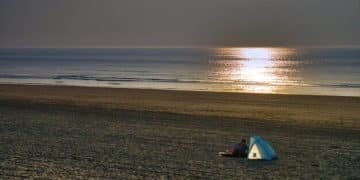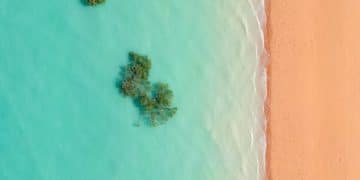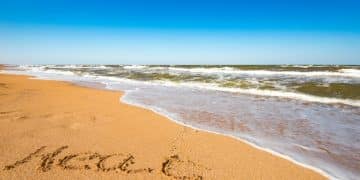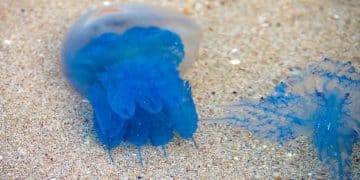Beachcombing Treasures: Identify, Collect Shells & Sea Glass
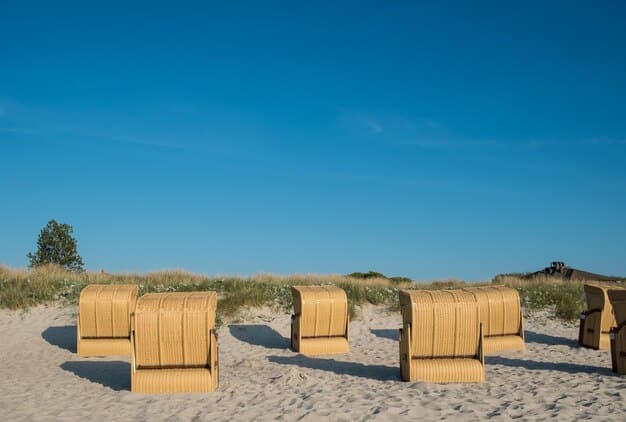
Beachcombing treasures involves exploring beaches to discover, identify, and collect unique seashells, sea glass, and other fascinating items washed ashore by the ocean’s tides.
Embark on an exciting journey to discover the hidden treasures the ocean leaves behind with beachcombing treasures. The thrill of finding unique shells and shimmering sea glass awaits you on sandy shores. This guide provides you with the knowledge to identify, collect, and appreciate these natural wonders, turning every beach visit into a treasure hunt.
The Allure of Beachcombing: More Than Just a Walk on the Beach
Beachcombing is more than just a leisurely walk on the beach; it is an adventure that combines relaxation with the excitement of discovery. The allure lies in the unexpected finds—each shell, piece of glass, or intriguing object tells a unique story of the sea.
This activity provides a wonderful opportunity to connect with nature, exercise, and even learn about marine life and coastal processes. Beyond the individual treasures, the overall experience of beachcombing fosters a deeper appreciation for the environment.
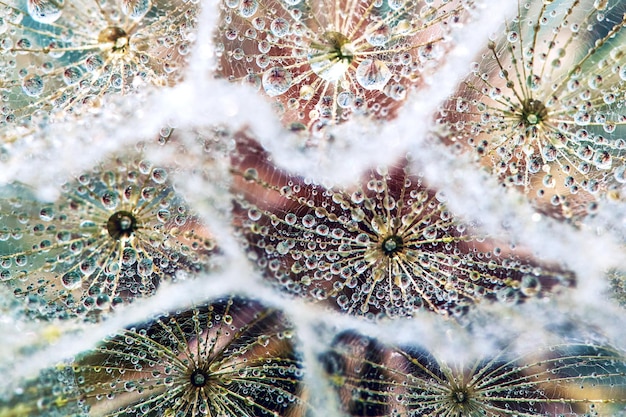
Why Beachcombing is So Appealing
Beachcombing appeals to a wide range of interests, from casual strollers to serious collectors. Here are a few reasons why it’s such a popular activity:
- Surprise and Discovery: Each visit offers the potential to find something new and exciting, keeping the experience fresh and engaging.
- Educational Opportunities: Identifying shells and understanding their origins provides insights into marine biology and oceanography.
- Relaxation and Mindfulness: The rhythmic sound of the waves and the focus required to spot treasures create a calming and meditative experience.
- Creative Inspiration: Found objects can inspire art projects, home decor, and creative writing endeavors.
Ultimately, the appeal of beachcombing is deeply personal and multifaceted, offering something unique for everyone who participates.
In conclusion, beachcombing offers a rich and varied experience that extends beyond a simple walk on the beach. It combines the thrill of discovery with educational opportunities and a deep connection with nature, making it an appealing activity for many.
Essential Gear for Beachcombing Success
Equipping yourself with the right gear ensures a comfortable and successful beachcombing adventure. While the equipment required is minimal, having the right tools can greatly enhance your experience and protect both you and the environment.
Having the right gear can make all the difference, keeping you safe and organized as you search for ocean treasures.
Must-Have Beachcombing Tools
Essential gear includes items for sorting your finds, protecting yourself, and respecting the environment:
- Collection Bag or Bucket: A sturdy container is necessary for carrying your treasures. Choose something durable and easy to clean.
- Gloves: Protect your hands from sharp objects and bacteria, especially in areas with debris.
- Sunscreen and Hat: Shield yourself from the sun to prevent sunburn and heatstroke.
- Water and Snacks: Stay hydrated and energized, especially during longer beachcombing sessions.
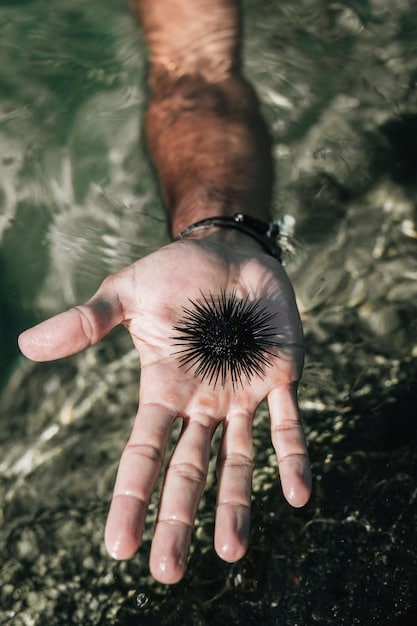
These simple items can make a big difference in your comfort and safety during your beachcombing excursions.
Optional Gear for Enhanced Beachcombing
Consider bringing these items for a more in-depth treasure hunt:
- Small Shovel or Trowel: Useful for digging in the sand to uncover buried treasures.
- Magnifying Glass: Helps to inspect small shells and sea glass for intricate details.
- Identification Guide: A field guide to local shells and marine life can enhance your learning experience.
- Camera: Document your finds and the beautiful scenery.
The right equipment will not only make your beachcombing more enjoyable but also help you appreciate the experience to the fullest.
In summary, having the right gear for beachcombing is crucial for both comfort and safety. From essential items like collection bags and gloves to optional tools such as shovels and magnifying glasses, being well-prepared ensures a more rewarding and enjoyable treasure hunting experience.
Shell Identification: Decoding Nature’s Art
Identifying seashells is a fascinating aspect of beachcombing, turning a simple collection into an educational journey. Understanding the different types of shells and their unique characteristics enriches your appreciation for marine life.
Learning to identify shells unlocks a deeper understanding of marine ecosystems and adds significant value to your collection.
Common Shell Types
There are several common types of shells you may encounter on your beachcombing adventures:
- Bivalves: These shells consist of two hinged halves, such as clams, mussels, and scallops.
- Gastropods: These are single-shelled creatures like snails, whelks, and conchs.
- Cephalopods: Though less common, you might find the internal shells (cuttlebones) of squid or octopus.
Key Features for Shell Identification
When identifying shells, pay attention to the following characteristics:
To accurately identify seashells, observe specific features and details that differentiate each species.
- Shape and Size: Note the overall form and dimensions of the shell.
- Color and Pattern: Observe the shell’s color and any patterns or markings.
- Texture: Feel the surface of the shell – is it smooth, ribbed, or spiny?
- Aperture: Examine the shape and size of the shell’s opening.
Identifying shells is a rewarding part of beachcombing, connecting you more closely to the marine environment.
In conclusion, shell identification is a rewarding and educational aspect of beachcombing. Understanding the different types of shells, recognizing their key features, and using field guides can transform a simple collection into a deeper exploration of marine life and coastal ecosystems.
Sea Glass: Transforming Trash into Treasure
Sea glass is a unique and beautiful find that adds a special charm to any beachcombing collection. These frosted, smooth fragments of glass have been tumbled and smoothed by the sea over many years, transforming them from discarded trash into valuable treasures.
Discover the beauty and history of sea glass, from its origins as discarded glass to its transformation into sought-after gems by the ocean.
What is Sea Glass?
Sea glass begins as discarded glass bottles and other items that find their way into the ocean. Over time, the waves, sand, and rocks break down and smooth the glass, giving it a frosted appearance.
This natural process can take decades, making each piece of sea glass a testament to the power of the ocean’s forces.
Uncover the secrets of sea glass – its origins, the factors that influence its colors, and how the ocean transforms it into a prized find.
Factors Affecting Sea Glass Color
The color of sea glass is determined by the original glass source. Common colors include:
- Green: Often from beer or soda bottles.
- White/Clear: Typically from food jars and bottles.
- Brown: Usually from beer, soda, or medicine bottles.
More rare colors, indicate unique sources.
- Blue: Often from medicine bottles or decorative items.
- Red and Orange: These are the rarest colors, typically from nautical lights or specific decorative glass.
In summary, sea glass is a unique and fascinating find that showcases the ocean’s ability to transform discarded materials into valuable treasures. Understanding its formation, the factors influencing its color, and the best strategies for finding it can greatly enhance the beachcombing experience.
Finding sea glass requires patience and a keen eye, but the reward is well worth the effort.
Best Beaches for Beachcombing in the U.S.
Selecting the right beach can significantly improve your chances of finding great treasures. Some beaches are naturally richer in shells and sea glass due to their location, currents, and coastal features.
Discover prime beachcombing locations across the U.S., where unique combinations of geography and tides create ideal conditions for finding shells and sea glass.
Top Beachcombing Locations
Here are some of the best beaches for beachcombing in the U.S.:
- Sanibel Island, Florida: Famous for its abundant seashells, thanks to its unique east-west orientation that scoops up shells from the Gulf of Mexico.
- Cape May, New Jersey: Known for its sea glass, as well as various shells due to its location along the Atlantic coast.
- Pacific Grove, California: A well-known location for an array of colorful sea glass due to the areas rich history.
When planning your beachcombing trip, consider these locations for the best finds.
Factors Influencing Beachcombing Success
Several factors can enhance your beachcombing experience:
- Tidal Timing: Low tide often reveals the most treasures, so plan your visit accordingly.
- Weather Conditions: After storms, beaches are often replenished with new finds.
- Seasonal Variations: Different seasons bring varying ocean conditions and, therefore, different types of treasures.
In planning a beachcombing trip, consider several key factors to maximize your chances of finding great treasures. Choosing the right location, timing your visit with low tide, and going after a storm can significantly enhance your beachcombing successes.
Ethical Beachcombing: Respecting the Environment
Ethical beachcombing is essential for preserving the natural beauty and ecological balance of coastal environments. It involves collecting responsibly and minimizing your impact on the ecosystem.
The best practices for ethical beachcombing, ensuring that you enjoy the hunt while protecting coastal environments.
Responsible Collection Practices
Follow these guidelines to ensure your beachcombing is ethical:
- Take Only What You Need: Avoid over-collecting. Take only a reasonable amount of what you find, leaving plenty for others and for the ecosystem.
- Leave Living Organisms: Do not collect live shells or disturb marine animals.
- Respect Protected Areas: Be aware of any restrictions or regulations in protected areas, such as marine reserves or national parks.
Minimizing Environmental Impact
Protecting the environment is key to sustainable beachcombing:
- Pick Up Trash: Collect any litter you find, even if it’s not yours. This helps keep the beach clean and safe for wildlife.
- Avoid Disturbing Wildlife: Keep a respectful distance from nesting birds and other coastal wildlife.
- Be Aware of Sensitive Habitats: Avoid trampling dunes or disturbing fragile ecosystems.
By following ethical beachcombing practices, you can contribute to the preservation of coastal environments, ensuring they remain beautiful and bountiful for future generations.
In conclusion, ethical beachcombing is a critical component of enjoying this activity responsibly. By following responsible collection practices and minimizing environmental impact, beachcombers can help preserve coastal environments.
| Key Point | Brief Description |
|---|---|
| 🐚 Shell Identification | Learn to identify different shell types (bivalves, gastropods) by shape, size, color, and texture. |
| 🌊 Sea Glass | Sea glass is transformed from trash glass into treasure |
| 📍 Best Beaches | Sanibel Island (FL), Cape May (NJ), and Pacific Grove (CA) have rich offerings. |
| 🌱 Ethical Beachcombing | Take only what you need, don’t disturb wildlife, and clean up trash. |
FAQ
▼
The best time to go beachcombing is during low tide, as this is when the most treasures are revealed. Additionally, consider going after a storm, as beaches are often replenished with new finds.
▼
You’re likely to find a mix of bivalves (like clams and scallops) and gastropods (like snails and whelks). The specific types will depend on your location and the local marine environment.
▼
Sea glass starts as discarded glass tossed into the ocean. Over time, waves and sand break it down, rounding the edges and frosting the surface, transforming trash into treasure.
▼
Yes, as long as you collect responsibly. Take only what you need, leave live shells and any living organism, avoid disturbing wildlife and always abide by protected area regulations.
▼
Essential gear includes a collection bag, gloves, sunscreen, a hat, water, and snacks. Optional items are a small shovel, magnifying glass, and a field guide to local shells.
Conclusion
Beachcombing offers a unique blend of adventure, education, and relaxation, transforming ordinary beach visits into exciting treasure hunts. With the right knowledge and respect for the environment, you can uncover the hidden gems of the shoreline and create lasting memories.

